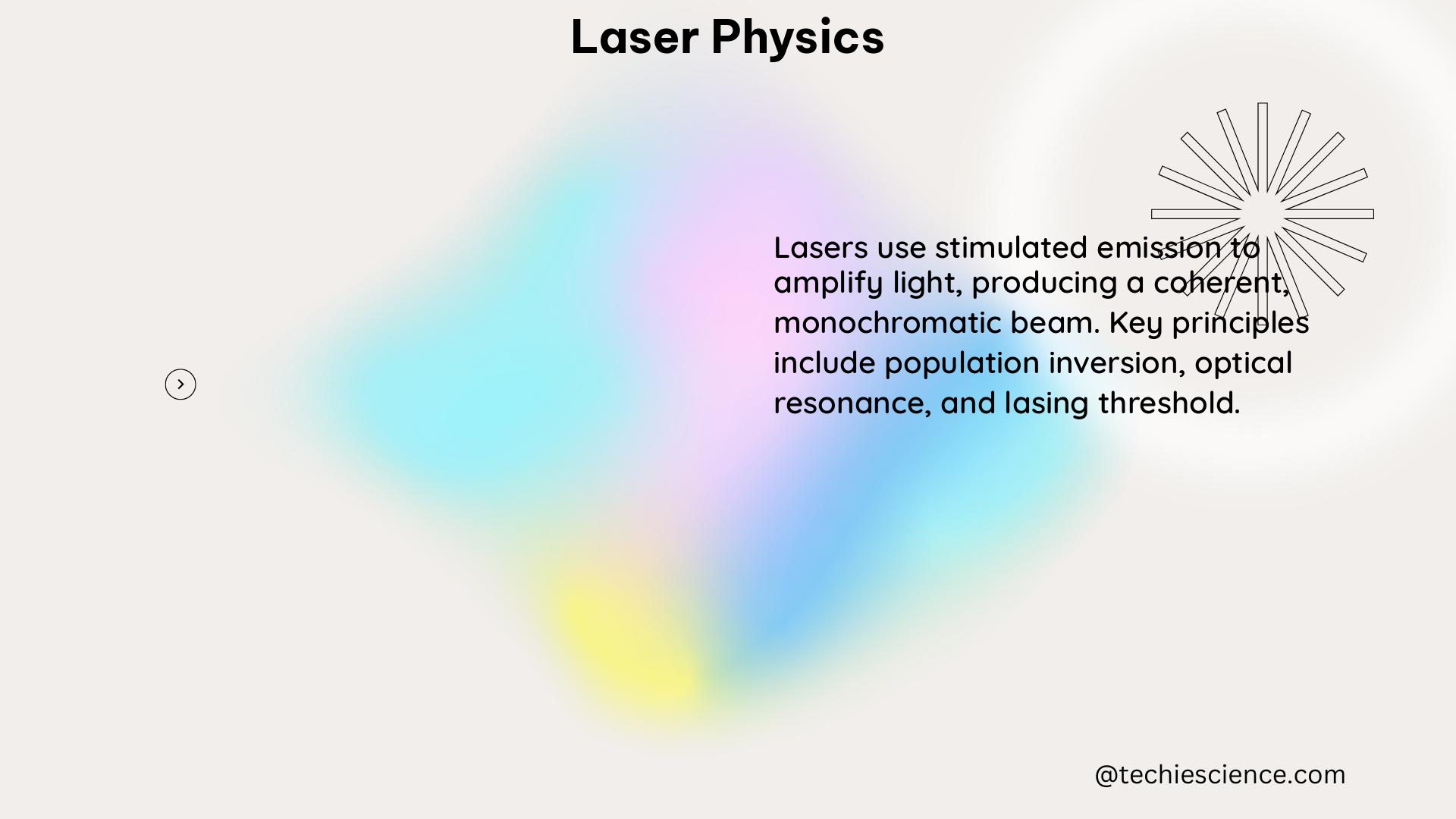Laser physics is a highly specialized field that delves into the fundamental principles of light amplification through stimulated emission of radiation. This comprehensive guide aims to provide science students with a deep understanding of the various aspects of laser physics, including the underlying theories, practical applications, and cutting-edge research in this dynamic field.
Wavelength and Spectrum
Lasers can emit light across a wide range of the electromagnetic spectrum, from ultraviolet to infrared wavelengths. The specific wavelength of a laser is determined by the energy transitions within the lasing medium, which can be a solid, liquid, or gas.
- Ultraviolet Lasers: These lasers operate in the wavelength range of 100 to 400 nanometers (nm) and are commonly used in applications such as photolithography, materials processing, and medical treatments.
- Visible Lasers: Visible lasers emit light in the wavelength range of 400 to 700 nm and are widely used in various applications, including laser pointers, barcode scanners, and laser light shows.
- Infrared Lasers: Infrared lasers operate in the wavelength range of 700 nm to 1 millimeter (mm) and are often used in telecommunications, remote sensing, and medical procedures.
The spectral bandwidth of a laser is a measure of the width of its emission spectrum, which is typically expressed in nanometers (nm) or hertz (Hz). Narrow-linewidth lasers, with a spectral bandwidth of less than 1 nm, are commonly used in applications that require high-precision frequency control, such as in atomic clocks and spectroscopy.
Laser Power and Efficiency

The power output of a laser is a crucial parameter that determines its suitability for various applications. Laser power is typically measured in watts (W) or milliwatts (mW), and can range from microwatts (μW) in low-power devices to megawatts (MW) in high-power systems.
The efficiency of a laser is the ratio of the output power to the input power, and is often expressed as a percentage. Factors that affect laser efficiency include the design of the laser cavity, the properties of the lasing medium, and the pumping mechanism.
For example, a typical helium-neon (HeNe) laser has an efficiency of around 0.1%, while a high-power carbon dioxide (CO2) laser can have an efficiency of up to 20%. Improving laser efficiency is an active area of research, as it can lead to more energy-efficient and cost-effective laser systems.
Laser Beam Characteristics
The quality and characteristics of a laser beam are crucial for many applications. Key beam parameters include:
- Beam Divergence: The angular spread of the laser beam as it propagates, typically measured in milliradians (mrad).
- Beam Diameter: The diameter of the laser beam, which can be measured at various points along the beam path.
- Beam Waist: The point along the beam path where the beam diameter is smallest, known as the beam waist.
- Beam Parameter Product (BPP): A measure of the beam quality, combining the beam divergence and beam waist, typically expressed in millimeters-milliradians (mm-mrad).
Lasers can produce beams with different spatial modes, such as the fundamental Gaussian mode (TEM00) or higher-order transverse modes (TEM01, TEM10, etc.). The choice of spatial mode depends on the specific application and the design of the laser system.
Laser Pulse Characteristics
In addition to continuous-wave (CW) operation, lasers can also be operated in pulsed mode, where the output is a series of short, high-intensity pulses. Key pulse characteristics include:
- Pulse Duration: The duration of a single laser pulse, typically ranging from femtoseconds (10^-15 s) to nanoseconds (10^-9 s).
- Pulse Energy: The energy contained within a single laser pulse, typically measured in joules (J).
- Pulse Repetition Rate: The number of pulses emitted per second, typically measured in hertz (Hz) or pulses per second (pps).
Pulsed lasers are used in a wide range of applications, such as materials processing, nonlinear optics, and time-resolved spectroscopy, where the high peak power and short pulse duration are crucial.
Laser Polarization
The polarization of a laser beam refers to the orientation of the electric field vector of the light. Lasers can produce linearly polarized, circularly polarized, or elliptically polarized light, depending on the design of the laser cavity and the properties of the lasing medium.
Polarization is an important parameter in applications such as optical communications, nonlinear optics, and quantum optics, where the precise control of the polarization state is essential.
Laser Coherence
Laser coherence is a measure of the degree of correlation between the phases of the light waves emitted by the laser. Lasers can be classified as either temporally coherent or spatially coherent, depending on the characteristics of the light they produce.
- Temporal Coherence: Refers to the consistency of the phase relationship between the light waves at different points in time. Temporally coherent lasers, such as single-mode gas lasers, have a well-defined frequency and can produce interference patterns over long distances.
- Spatial Coherence: Refers to the consistency of the phase relationship between the light waves at different points in space. Spatially coherent lasers, such as single-mode semiconductor lasers, can produce highly collimated beams that can be focused to a small spot size.
The coherence length of a laser is a measure of the distance over which the laser’s phase relationship remains constant, and is typically expressed in meters (m) or centimeters (cm).
Laser Physics Principles
Laser physics is underpinned by a deep understanding of various physical principles, including quantum mechanics, electromagnetism, and optics. Some of the key principles and concepts in laser physics include:
- Stimulated Emission: The process by which an excited atom or molecule can be induced to emit a photon of the same frequency, phase, and direction as an incident photon, forming the basis of laser operation.
- Population Inversion: The condition where the population of atoms or molecules in the upper energy level is greater than the population in the lower energy level, a necessary requirement for laser action.
- Optical Resonator: The cavity formed by two or more mirrors that allows the amplification of light through multiple passes, leading to the generation of a laser beam.
- Gain Medium: The material, such as a gas, solid, or liquid, that provides the necessary population inversion and amplification of the light within the laser cavity.
- Pumping Mechanism: The process of providing energy to the gain medium, such as through electrical discharge, optical absorption, or chemical reactions, to create the population inversion.
Understanding these fundamental principles is crucial for the design, development, and optimization of laser systems for various applications.
Laser Applications
Lasers have a wide range of applications in various fields, including:
- Materials Processing: High-power lasers are used for cutting, welding, drilling, and surface treatment of materials in industrial settings.
- Telecommunications: Lasers are used as the light source in fiber-optic communication systems, enabling high-speed data transmission over long distances.
- Medical and Biomedical: Lasers are used in various medical procedures, such as eye surgery, tumor removal, and tissue ablation, as well as in diagnostic techniques like spectroscopy and imaging.
- Scientific Research: Lasers are essential tools in many areas of scientific research, including spectroscopy, interferometry, and quantum optics.
- Entertainment and Displays: Lasers are used in laser shows, laser light displays, and laser projectors for entertainment and advertising purposes.
The versatility and capabilities of lasers continue to expand, leading to new and innovative applications in various industries and research fields.
Conclusion
Laser physics is a complex and multifaceted field that encompasses a wide range of theoretical and practical aspects. This comprehensive guide has provided science students with a detailed overview of the key concepts, parameters, and principles that underlie the behavior and applications of lasers.
By understanding the fundamental aspects of laser physics, such as wavelength, power, beam characteristics, pulse properties, and the underlying physical principles, students can develop a strong foundation for further exploration and research in this dynamic field. The wealth of information and references provided in this guide should serve as a valuable resource for anyone interested in the fascinating world of laser physics.
References
- Laser Physics – DTIC: https://apps.dtic.mil/sti/tr/pdf/ADA346696.pdf
- Laser Physics and Applications: https://ehs.msu.edu/_assets/docs/laser/laser-fundamentals-pt1-springer-2005.pdf
- High-Power Laser Science and Engineering: https://www.cambridge.org/core/journals/high-power-laser-science-and-engineering/article/datadriven-science-and-machine-learning-methods-in-laserplasma-physics/B50C69868941B26062ECF6AFCF2BF3B9

Hi, I am Sanchari Chakraborty. I have done Master’s in Electronics.
I always like to explore new inventions in the field of Electronics.
I am an eager learner, currently invested in the field of Applied Optics and Photonics. I am also an active member of SPIE (International society for optics and photonics) and OSI(Optical Society of India). My articles are aimed at bringing quality science research topics to light in a simple yet informative way. Science has been evolving since time immemorial. So, I try my bit to tap into the evolution and present it to the readers.
Let’s connect through